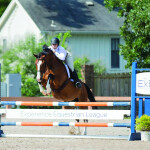Cooler temperatures bring different equestrian challenges. One of those is determining how much warm-up and cooldown is needed when riding in the cold. In the heat of summer, it is easy to assume the horse is already warm and ready to go. However, when the temperatures drop, equestrians need to take into consideration more effort is required to properly warm-up and cooldown the horse.
Mindi Harrison, owner of Broken Wheel Ranch in Trenton, Tenn., and volunteer trainer at Redemption Road Horse Rescue in Jackson, Tenn., says her warm-up consists of two components: flexing and walking circles. Flexion, or asking for suppleness from the horse as you bend its nose toward your knee while in the saddle, is a great way to prepare your horse for a ride. “Flexing fixes so many problems,” Mindi states, “including standing still, softness, and attention problems.” It’s also of utmost importance because it’s the basis for the one-rein stop, which, according to Mindi, is the best way to refocus your horse’s attention back on you, the rider, if your horse is acting up. Mindi asserts, “You can’t practice flexing too much.”
Walking lots of circles is the second part of Mindi’s warm-up. Not only does it provide physical warmth to the horse’s muscles, but it is also the quickest way to control your horse, she says. Walking circles around cones, trees, or whatever you have available mimics the way a dominant horse circles and controls its herd members. “When you walk circles, that gives you the control,” Mindi states. Walking circles, not trotting or cantering is a part of Mindi’s cooldown as well. This reinforces the rider is in control over the horse, which is paramount in the equine-equestrian relationship.
A full winter coat can intensify sweating, so whether you plan to ride indoors or outdoors this winter, always assess your horse after the ride. If your horse is sweating once you’ve cooled down, Mindi recommends putting a wool blanket over it with another blanket on top of that. The wool blanket will wick away the moisture, and the extra blanket on top will keep the heat locked in so the horse can dry. Never put a non-wicking blanket on a sweaty horse, as the hair won’t be able to dry.
Brittany Stang, a local horse trainer here in the mid-south, suggests incorporating stretching into the cooldown after a ride on a cold day. This will help your horse’s muscles remain warm and pliable. There are many different types of stretches you can perform on your horse, including both shoulder and hip flexors, and extensors. Just like humans, these stretches are most effective when done after a workout. Increased flexibility and decreased risk of injury are just two wonderful benefits of stretching your horse. Studies have shown improvements in both speed and power in performance horses from adding static equine stretches into a warm-up and cooldown routine. If you do choose to add stretching to your routine, do your research first, as it is possible to do more harm than good to your horse if you are unaware of proper equine stretching techniques.
Whether you choose to ride or just keep your horse tuned up on the ground this winter, be sure to give your partner the proper warm-up and cooldown he or she deserves.









